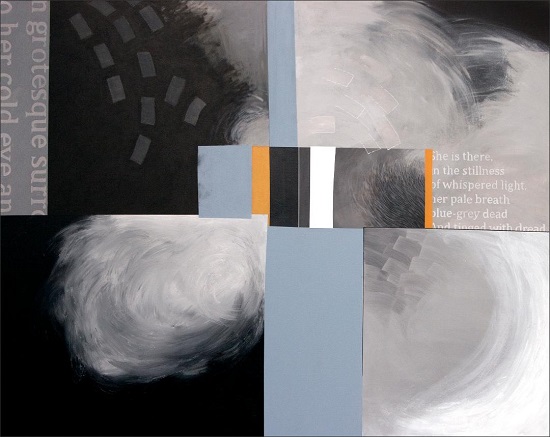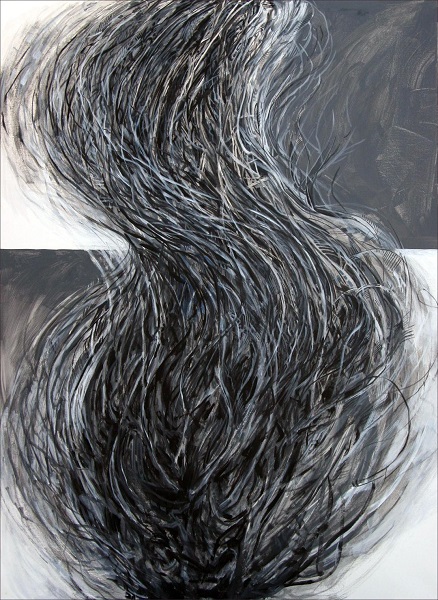With yet another gallery neighborhood developing in Tribeca, keeping abreast of New York City’s balkanized exhibition districts adds to the challenge of planning visits to venues scattered along the city’s outer regions. This is unfortunate because there are quite a few exhibition spaces, particularly on college campuses, whose noncommercial curatorial focus provides access to work that tends to slip past the art market trawlers. Frank Lind’s landscape painting exhibition this past spring at the Kingsborough Art Museum in south Brooklyn was a notable example.
Now we have “Colorless and Odorless” at the Fine Arts Gallery of Westchester Community College in Valhalla, NY, 45 minutes north of the city. Featuring painter and graphic designer Edward Burke, the public can, until October 4, 2019, spend time with a body of work that offers a promising alternative to the extremes that continue to divide a splintered art world.
.
.
In a recent essay in the online magazine Interalia titled, In Praise of Form: Towards a New Post-Humanist Art, artist and writer Taney Roniger, in defense of maligned trends in contemporary abstract painting, reminds us that divisions formed in the 1960s between formalist painting and conceptual art are still with us. Her timely discourse lends particular significance to Burke’s unique melding of politically discursive subject matter offered through a strong formalist aesthetic.
With a substantial background in both graphic design and in painting, Burke is uniquely positioned to dodge the anxiety that often hamstring’s painters wishing to illustrate a subject. At home in the communicative design space but drawn to the subjective intimacy of a painter’s studio, Burke keeps both masters in line with an unbiased sense of what art can be. The effectiveness of his result is apparent in several pieces that stand out in a wide-ranging exhibition of painting, drawing, sculpture and written text.
.
.
What impressed me about his abstract paintings in particular was how their formal integrity held up to their polemic application. The canvas, Plastic Sea, 2012, consists of a nebulous cloud of black, white and grey particles rendered to appear densely packed on a white ground. But along its irregular edges, fragments resembling calligraphic flourishes loosen and break away.
The freed pieces emphasize their three-dimensional properties, appearing like random shavings off a block of homogenous material. But deeper in the cloud, where their inevitable overlapping pulls them toward a unified mass, the artist applies hard-edged divisions of black, white and grey that follow the logic of the picture plane, not the implied shape of each fragment. The result is a kind of camouflage that fuses individual elements into a semi-coherent aggregate, which in turn deconstructs the illustrative aspect of the image, subsuming it into a painterly expression.
.
.
The result is an image that maintains a largely abstract presence yet, as a whole, resembles any number of natural phenomena—flocks of birds, schools of fish, clouds of locusts—all of which are nudged aside by a title that directs one’s perception to the clumps of plastic refuse we’ve all seen on the news drifting in our oceans. Plastic Sea is not an illustration of this phenomenon nor does it exploit the subject’s unpleasant visual aspect. In strictly aesthetic terms, it’s quite mesmerizing. But as a viewer absorbs the significance of its title, its compelling narrative conjures a freakish biological anomaly taking on a life of its own, proving that an abstract metaphor has the advantage of an unbound narrative.
Another canvas, Discarded Landscape, 2013, applies an all-over field of grey markings on a dark background that remind one of Keith Haring’s tremoring glyphs. The shapes tease the eye into seeing distinctive items—boxes, cans, bags—but none commit to any specific identity. More like the hatching Jasper Johns used in his “Dutch Wives” series, the pattern reinforces the painting’s surface. Two thirds of the way down the frame, the ground changes to a lighter gray of less contrast, dividing the image into an upper and lower region separated by a clean hard edge. With its formalist neutrality punctured by a context insisted by the title, one of two literal possibilities surface: a landfill absorbing foreign material while leaving it unchanged, or a body of water doing the same.
.
.
The exhibition does not only include abstraction. Two pieces visualize the issue in more direct terms. I Am the Problem #2 features an unambiguous image of a plastic shopping bag rendered in fine black and white hatching on grey paper. Maintaining its Walmart logo as it rises from the material’s wrinkles, the wrinkles are the only destruction the item is likely to suffer as the plastic will remain unscathed through time.
.
.
Turning again to a large canvas, Windswept, 2015, correlates unambiguously to the dramatic flow of curving brushstrokes, offset by a quartet of geometric forms that anchor its tumbleweed animation to the vertical canvas, suggesting a natural event in an unnatural, perhaps urban environment. Visually it says no more than that. It persists as a painting.
.
.
Illustration, and all that word implies, represents a simmering dilemma the artworld has so far managed to avoid. But with the word "figuration" cropping up so often in critical writing (a timid placeholder if there ever was one), largely because painters have grown comfortable merging the abstract with the identifiable, artists like Burke, holding no bias against either form of visual communication, offer a needed release from the unnecessary anxiety triggered by the comparison of fine arts with illustration.
________________________________
BASIC FACTS: "Edward Burke: Colorless and Odorless" is on view September 3 to October 4, 2019 at the Fine Arts Gallery in the Hankin Academic Arts Building located at Westchester Community College, 75 Grasslands Road, Valhalla, NY 10595. www.sunywcc.edu.
________________________________
Copyright 2019 Hamptons Art Hub LLC. All rights reserved.






